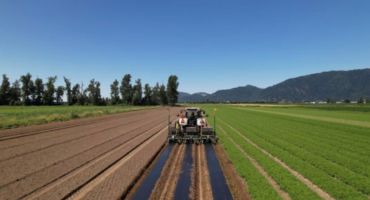Creating The Best Match of Carriers & Attachments
Bobcat focuses on enabling customers to perform their tasks quickly and efficiently by offering a wide range of compact machines designed as tool carriers and an extensive range of attachments for these machines. The power available, coupling systems, hydraulics and the Attachment Control Device (ACD) on Bobcat machines are all designed to facilitate the quick change of attachments and to allow customers to perform a wide range of tasks with the same machine. Working with attachments is an attractive choice from an investment point of view, especially for multidisciplinary companies. “We supply one of the most extensive programs of attachments, with which you can carry out all common activities in construction, landscaping, agriculture, demolition, recycling and material handling. That is why all of our compact machines have been developed as tool carriers,” explains Katinka Kincses, Product Manager Attachments at Bobcat EMEA. “Yet it is important to choose the right products from Bobcat. For example, a skid-steer loader is strong and agile, but for use on sensitive terrain where you do not want to disturb the soil too much, it is better to use a compact track loader. Power also plays a role. If you want to use a forestry mulcher, a wheel saw or a snow plough, you will need to purchase a heavy-duty machine. If you want to work at a high driving speed, a skid-steer loader is not suitable and it is better to use a compact wheel loader. If lifting height and reach are important, a compact wheel loader or a telehandler are the more obvious choices. Compact wheel loaders also have the advantage that the driver sits higher and has a better view of the work area.” Kincses believes that a customer should only purchase a specialist machine if they do the same, specialist work all day long. “For golf course maintenance, a ride-on mower from Bobcat is a great investment, but in most other cases a multi-purpose tool carrier is a wiser investment, because you can carry out more work and projects, work all year round and therefore use the machine more intensively. You often see that a new customer buys a machine with three or four attachments and gradually adds another three or four attachments, so that they can do as much work as possible with the same machine.” More than 120 Attachments to Choose From Once customers have made their choice of machine, they can choose from more than 120 attachments on offer from Bobcat, many of which are intercompatible between different Bobcat tool carriers. For convenience, Bobcat has subdivided the attachments based on activity: including demolition, construction, roadworks, landscaping, forestry, agriculture and material handling. The range is particularly wide, especially for landscaping and road construction, but many attachments can be used for general work: such as buckets, grabs, clamps, pallet forks, roller brushes, dozer blades, graders, rakes, flail mowers, trenchers, drills and demolition hammers. In addition, there are specialist attachments such as vibrating rollers, concrete mixers, concrete buckets, planers, high-pressure water cleaners, work platforms, woodchippers and even a tree transplanter. Attachment Control Device Bobcat has integrated a lot of functionality into the machines and attachments to enhance their connectivity and operation. The company’s Bob-Tach system for connecting attachments is the industry standard, but since (the early 2000s) the Power Bob-Tach system has also been available, which allows the operator to connect and disconnect non-hydraulic attachments without the need to leave the cab. Another useful feature is the speed management system which allows adjustment of the travel speed independently from the engine speed, allowing for higher productivity. The ACD is built into the attachment. It is a CANbus system that controls the communication between the machine and the attachment. Thanks to the ACD, the machine recognizes the attachment and automatically adjusts the settings of, among other things, the joystick controls and the hydraulics. The driver can adjust the settings on the display in the machine and receive an overview of the operating hours, performance and status of the attachment. If an operator uses remote control to work their machine, all functions for controlling the attachment are also automatically available. Bobcat with Bobcat Katinka Kincses advises customers to use Bobcat attachments on their Bobcat carriers: “Our machines and attachments are optimally matched and tested. For example, you can be sure that the attachment’s software is always up to date and functions works optimally through controls available in the cab; that the hydraulic system is suitable for its tasks and that you can use all functions of the attachment. If there are technical problems, Bobcat can solve them within the warranty period and you are not stuck between two suppliers pointing fingers at each other. “A good example of the adaptation

Bobcat focuses on enabling customers to perform their tasks quickly and efficiently by offering a wide range of compact machines designed as tool carriers and an extensive range of attachments for these machines.

The power available, coupling systems, hydraulics and the Attachment Control Device (ACD) on Bobcat machines are all designed to facilitate the quick change of attachments and to allow customers to perform a wide range of tasks with the same machine. Working with attachments is an attractive choice from an investment point of view, especially for multidisciplinary companies.
“We supply one of the most extensive programs of attachments, with which you can carry out all common activities in construction, landscaping, agriculture, demolition, recycling and material handling. That is why all of our compact machines have been developed as tool carriers,” explains Katinka Kincses, Product Manager Attachments at Bobcat EMEA.
“Yet it is important to choose the right products from Bobcat. For example, a skid-steer loader is strong and agile, but for use on sensitive terrain where you do not want to disturb the soil too much, it is better to use a compact track loader. Power also plays a role. If you want to use a forestry mulcher, a wheel saw or a snow plough, you will need to purchase a heavy-duty machine. If you want to work at a high driving speed, a skid-steer loader is not suitable and it is better to use a compact wheel loader. If lifting height and reach are important, a compact wheel loader or a telehandler are the more obvious choices. Compact wheel loaders also have the advantage that the driver sits higher and has a better view of the work area.”
Kincses believes that a customer should only purchase a specialist machine if they do the same, specialist work all day long. “For golf course maintenance, a ride-on mower from Bobcat is a great investment, but in most other cases a multi-purpose tool carrier is a wiser investment, because you can carry out more work and projects, work all year round and therefore use the machine more intensively. You often see that a new customer buys a machine with three or four attachments and gradually adds another three or four attachments, so that they can do as much work as possible with the same machine.”
More than 120 Attachments to Choose From
Once customers have made their choice of machine, they can choose from more than 120 attachments on offer from Bobcat, many of which are intercompatible between different Bobcat tool carriers. For convenience, Bobcat has subdivided the attachments based on activity: including demolition, construction, roadworks, landscaping, forestry, agriculture and material handling.

The range is particularly wide, especially for landscaping and road construction, but many attachments can be used for general work: such as buckets, grabs, clamps, pallet forks, roller brushes, dozer blades, graders, rakes, flail mowers, trenchers, drills and demolition hammers. In addition, there are specialist attachments such as vibrating rollers, concrete mixers, concrete buckets, planers, high-pressure water cleaners, work platforms, woodchippers and even a tree transplanter.
Attachment Control Device
Bobcat has integrated a lot of functionality into the machines and attachments to enhance their connectivity and operation. The company’s Bob-Tach system for connecting attachments is the industry standard, but since (the early 2000s) the Power Bob-Tach system has also been available, which allows the operator to connect and disconnect non-hydraulic attachments without the need to leave the cab. Another useful feature is the speed management system which allows adjustment of the travel speed independently from the engine speed, allowing for higher productivity.
The ACD is built into the attachment. It is a CANbus system that controls the communication between the machine and the attachment. Thanks to the ACD, the machine recognizes the attachment and automatically adjusts the settings of, among other things, the joystick controls and the hydraulics.
The driver can adjust the settings on the display in the machine and receive an overview of the operating hours, performance and status of the attachment. If an operator uses remote control to work their machine, all functions for controlling the attachment are also automatically available.

Bobcat with Bobcat
Katinka Kincses advises customers to use Bobcat attachments on their Bobcat carriers: “Our machines and attachments are optimally matched and tested. For example, you can be sure that the attachment’s software is always up to date and functions works optimally through controls available in the cab; that the hydraulic system is suitable for its tasks and that you can use all functions of the attachment. If there are technical problems, Bobcat can solve them within the warranty period and you are not stuck between two suppliers pointing fingers at each other.
“A good example of the adaptation of machine and attachment is the combination of the new FRC 200XT forestry cutter and the S86 or T86 top-of-the-range loaders. To work with powerful tools like this, these machines have the option of a high-flow function and a super-flow function, which increases the standard flow of the auxiliary hydraulics from 87 l/min to 138 l/min or 159 l/min. To use the forestry cutter, a special ready-to-use forestry kit must also be installed on the loader, which protects the engine, machine, couplings and operator.

Product Development
As Attachments Product Manager, Katinka Kincses is responsible for product development, marketing, additional services and training.
“I view my department as the voice of the customer. We map out their wishes and conduct field research to develop new attachments and new functions. We have two important principles.
“The first is the fact that job sites are becoming smaller and that the demand for compact machines and compact attachments is increasing. In addition, ease of use is becoming increasingly important. Many companies are struggling with staff shortages, which means you need to offer alternatives to human labour.
“Young and inexperienced employees must also be able to operate the machines and attachments without extensive training, so that productivity is still maintained. This can also be done through automation. For example, look at the modern grader. There is so much technology there that the machine can perform its work almost autonomously.”
From her position of responsibility for product development, Katinka Kincses does not want to say too much now about the latest attachment launches planned by Bobcat. She comments: “But we are working on interesting things that will see the light of day next year.”
www.bobcat.com
Powered by
Induportals Media Publishing

 machineryasia
machineryasia 





